A savage battle
Mosul -- I have covered nearly the entire nine months that Iraqi forces spent retaking Mosul from Islamic State jihadists. I would spend weeks at the front with the soldiers, witnessing the killing, smelling the stench of death. I was gone so much that when I would come home for a few days of rest, my two-year-old daughter no longer recognized me. Why go through all that? I am Iraqi and I saw it as my duty to show to the outside world what was happening here.
To me, the battle for Mosul was the most important over the past 14 years, since the fall of Saddam Hussein, because I think it is the beginning of the end of the Islamic State, the brutal extremists who at one point took over two-thirds of Iraq and were threatening the capital Baghdad.
Covering the battle took its toll on me psychologically. I saw so much killing. The smell of death was always present, sometimes for days on end.
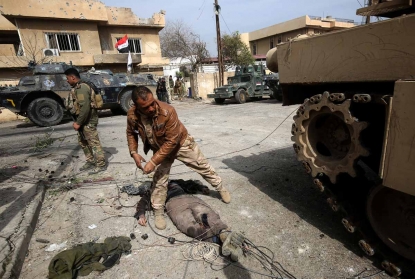 Iraqi forces stand next to the body of an alleged Islamic State (IS) group fighter as they advance through Mosul's Jawasaq neighbourhood on February 27, 2017, during an offensive to retake the area from the jihadists.
(AFP / Ahmad Al-rubaye)
Iraqi forces stand next to the body of an alleged Islamic State (IS) group fighter as they advance through Mosul's Jawasaq neighbourhood on February 27, 2017, during an offensive to retake the area from the jihadists.
(AFP / Ahmad Al-rubaye)Mosul was an especially savage battle. The militants were surrounded in an area where they had been entrenched for several years. The presence of civilians made it even more bloody. Often I would witness fighting between Iraqi forces and IS forces in small alleyways. I would see bodies of IS fighters still wearing their suicide belts, bodies of civilians starting to decompose.
In my pictures, I always tried to show the human condition and the emotions that I saw, be it the frightened civilians stuck in alleys during the fighting, or the determination of the forces fighting to free the city from the IS, or the fear of the soldiers fighting the extremists for the first time.
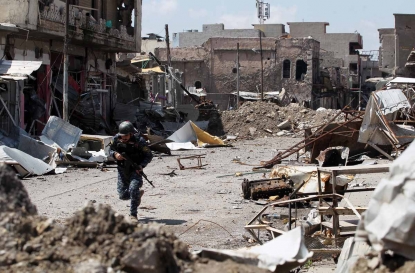 A member of the Iraqi forces manoeuvres through the rubble in a street in the old city of Mosul on April 15, 2017, during an offensive to recapture the city from Islamic State (IS) group fighters. (AFP / Ahmad Al-rubaye)
A member of the Iraqi forces manoeuvres through the rubble in a street in the old city of Mosul on April 15, 2017, during an offensive to recapture the city from Islamic State (IS) group fighters. (AFP / Ahmad Al-rubaye) Iraqi children rest on their way, while fleeing from the Old City of Mosul on July 5, 2017, during the Iraqi government forces' offensive to retake the city from Islamic State (IS) group fighters. (AFP / Ahmad Al-rubaye)
Iraqi children rest on their way, while fleeing from the Old City of Mosul on July 5, 2017, during the Iraqi government forces' offensive to retake the city from Islamic State (IS) group fighters. (AFP / Ahmad Al-rubaye)
Fear was ever present during the fighting. Fear is natural. You’re in the middle of the battle, so there’s always a danger that you will be killed. The journalists were always on alert to avoid snipers, who were highly trained and very skilled and seemed to target journalists. Then there was the danger of improvised explosive devices planted in alleyways, buildings and cars.
On some days I imagined myself going home wounded or dead. Once in the Old City, we were trapped by IS fighters in a spot for seven hours. We all faced the fact that we may not come out alive, but thank God reinforcements eventually came and the IS militants fled.
You saw and felt the fear when civilians would flee their homes and walk toward Iraqi forces. Those poor people. They hadn’t seen government forces in more than three years. During those years, they were living under the cruelty of the Islamic State militants, who were telling them that the government forces would come and kill them and rape their women. So obviously they were afraid. Of everyone and everything.
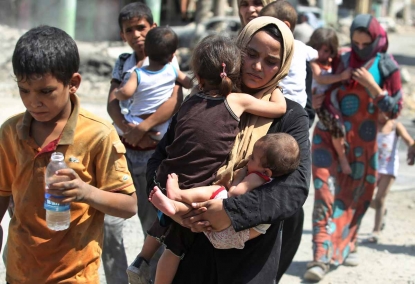 Iraqis flee from the Old City of Mosul on July 5, 2017, during the Iraqi government forces' offensive to retake the city from Islamic State (IS) group fighters.
(AFP / Ahmad Al-rubaye)
Iraqis flee from the Old City of Mosul on July 5, 2017, during the Iraqi government forces' offensive to retake the city from Islamic State (IS) group fighters.
(AFP / Ahmad Al-rubaye)In situations like those, my role was more humanitarian than journalistic. I used to walk toward the people and say loudly, “Thank God for your safety!” To put them at ease. Sometimes I carried candy to give to the children, so they would feel safe and welcomed. When I would see a woman carrying a crying child, I would approach her and address her as “my sister” to make her feel safe. They would often open up to me about the life that they had led under the three years of IS occupation. I was happy to offer any help and reassurance that I could to these people, who went through so much under IS.
When you cover so much carnage, there are so many scenes that stick in your mind long after you’ve lived through them. I will never forget the Yazidis when IS got to Sinjar mountain in 2014, trapping thousands on the mountain top and forcing scores to flee. I saw some heartbreaking scenes in Dohuk, where women and children were sleeping in the open. One woman gave birth under a bridge, with her husband standing over her, holding her IV solution. That scene always pops into my head now every time I’m in a hospital or medical center.
 Iraqi Yazidis, who fled their homes a week ago when Islamic State (IS) militants attacked the town of Sinjar, gather at a makeshift shelter on August 10, 2014 in the Kurdish city of Dohuk in Iraq's autonomous Kurdistan region. (AFP / Ahmad Al-rubaye)
Iraqi Yazidis, who fled their homes a week ago when Islamic State (IS) militants attacked the town of Sinjar, gather at a makeshift shelter on August 10, 2014 in the Kurdish city of Dohuk in Iraq's autonomous Kurdistan region. (AFP / Ahmad Al-rubaye)Another scene is of a man carrying a six-year-old boy who had been hit by a sniper’s bullet in Ein Jahesh area west of Mosul. He walked up to us, put his son on the ground and started to sob. After he calmed down a bit, he told us his story.
“I live in a village nearby. I was fleeing IS fighters with my wife and two boys. They shot and killed my wife. I left her body where it was and went back to our house. When night fell, I decided to try to escape again with my two children. On the way, a sniper shot and killed one of my children, so I buried him in a dark place on the road.”
Trouble was he buried the son who was alive. Both of the boys were covered in blood and the one alive was in a deep sleep. The father was so tired and so scared, and it was so dark, that he chose the wrong son. He didn’t realize his mistake until it was too late. We later learned that he had gone mad.
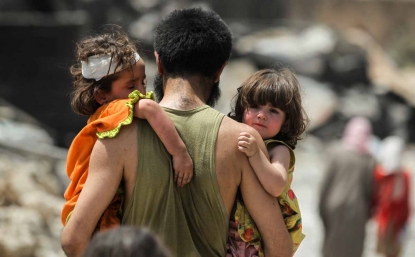 A man carries two children in his arms hile fleeing from the Old City of Mosul on July 2, 2017, as Iraqi government forces continue their offensive to retake the city from Islamic State (IS) group fighters. (AFP / Ahmad Al-rubaye)
A man carries two children in his arms hile fleeing from the Old City of Mosul on July 2, 2017, as Iraqi government forces continue their offensive to retake the city from Islamic State (IS) group fighters. (AFP / Ahmad Al-rubaye)That scene drove me to tears. As I heard him speak, I was in such shock that I couldn’t bear raising my camera to take a picture of him. I am a father myself and the horror of what that man went through really struck to the heart.
Scenes like this still haunt me. Especially when I am sitting alone with my thoughts.
Once the battle for Mosul was nearly over, I wanted to convey what the people would see and feel once they returned home. To see their homes lying in rubble. The best place to do that is from a vantage point. The position that I eventually got was used by IS fighters to keep an eye on the surrounding area. When I got there, I was shocked to see the scale of destruction in Mosul’s old city. When I saw that, I felt as if I was in Syria, the scale of the devastation was that large.
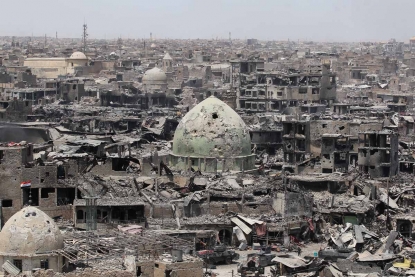 A picture taken on July 9, 2017, shows a general view of the destruction in Mosul's Old City.
(AFP / Ahmad Al-rubaye)
A picture taken on July 9, 2017, shows a general view of the destruction in Mosul's Old City.
(AFP / Ahmad Al-rubaye)I never expected the destruction to be so severe. I have covered battles before, but have never seen destruction like this. Iraq’s second city, and its most beautiful, is now in ruins.
As the battle wound down, I enjoyed taking pictures of happiness in the faces of both civilians and the fighters. For the civilians, it was a symbol of the end of the tragedy of IS occupation, a start of their dream to return to their homes. For the fighters, it’s a symbol of a hard-earned victory.
 An Iraqi man displaced from the city of Mosul shaves off a man's beard following their arrival at a camp in the Hamam al-Alil area south of the embattled city on March 11, 2017, during the government forces ongoing offensive to retake the area from Islamic State (IS) group fighters. (AFP / Ahmad Al-rubaye)
An Iraqi man displaced from the city of Mosul shaves off a man's beard following their arrival at a camp in the Hamam al-Alil area south of the embattled city on March 11, 2017, during the government forces ongoing offensive to retake the area from Islamic State (IS) group fighters. (AFP / Ahmad Al-rubaye)When the battle came to an end and most of the city was liberated from the IS extremists, I felt mixed emotions. I was happy because I would finally get to spend time with my family. Throughout the battle, I stayed away for more than a month at a time, coming home for a few days of rest. My two-year-old daughter wouldn’t recognize me when I came home. When I picked her up, she would cry and want to be with her mother. Whenever I would leave again, my family would be sad and anxious. So many journalists had lost their lives, they would worry for me.
I was also sad because I have known so many people close to me who have died in this battle. I wish they were still alive so that we could all celebrate this victory together.
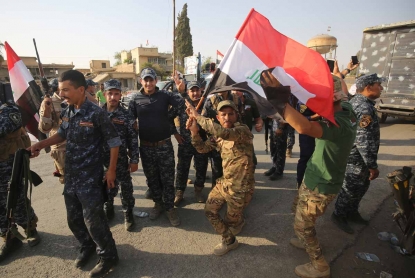 Iraqi federal police members celebrate in the Old City of Mosul on July 9, 2017 after the government's announcement of the liberation of the embattled city.
(AFP / Ahmad Al-rubaye)
Iraqi federal police members celebrate in the Old City of Mosul on July 9, 2017 after the government's announcement of the liberation of the embattled city.
(AFP / Ahmad Al-rubaye)My works depends on having good contacts with the Iraqi forces. Because I’ve been working as a photographer in the country for so long, I had direct contacts with security officials. Some of the friends that I made years ago had risen through the ranks and were leaders in the Mosul battle. This was crucial, as I could communicate with them directly. Other friends have become media officials. That, along with the fact that I am Iraqi and speak the language, made it much easier for me to move around.
That also set me apart from the myriad of other photographers that AFP sent on missions to help cover the battle. Every photographer has his or her own style and sees things in a different perspective and from different angles. But the fact that I had such close connections with officials gave me more freedom to move about.
 An Iraqi forces member runs for cover as they fight Islamic State (IS) group fighters on June 19, 2017 during a battle to retake the last district of the Old City of Mosul still held by the jihadists.
(AFP / Ahmad Al-rubaye)
An Iraqi forces member runs for cover as they fight Islamic State (IS) group fighters on June 19, 2017 during a battle to retake the last district of the Old City of Mosul still held by the jihadists.
(AFP / Ahmad Al-rubaye)There is also the continuity. Since I was there for most of the time, I got to know the people well. When you’re living day in and day out with people, going into battle with them, you develop a very strong bond, you look out for one another.
There was also an association that local journalists formed after Mosul fell to the IS jihadists in 2014 and through which we maintained a direct line of communication with military and government media officials. We kept in touch using chat apps and this ease in communication helped us prepare for coverage, as we could bypass paperwork and get down to work.
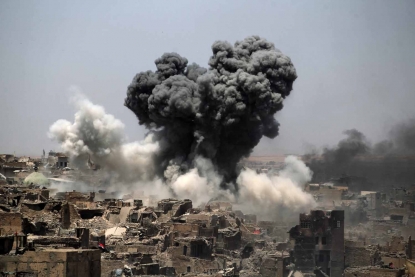 A picture taken on July 9, 2017, shows smoke billowing following an airstrike by US-led international coalition forces targeting Islamic State (IS) group in Mosul.
(AFP / Ahmad Al-rubaye)
A picture taken on July 9, 2017, shows smoke billowing following an airstrike by US-led international coalition forces targeting Islamic State (IS) group in Mosul.
(AFP / Ahmad Al-rubaye)Although the IS had been driven out of most of Mosul, they still control pockets in the city, and in the rest of Iraq, like the Anbar province. I will cover battles to retake these places. And once there is no more IS in Iraq, I will go back to my normal coverage of the country.
The battle of Mosul is probably one of the most important stories that I have covered. For me, it was a mixture of journalistic and humanitarian work. I was able to witness both tragedy and joy and I will always remember it. I lost a lot of friends, but I also made lots of new ones. I am happy with my coverage. But I hope that I won’t see anything else like it, be it in Iraq or any other part of the world.
I have been covering what has been happening in Iraq since the fall of Saddam Hussein in 2003. And the Mosul battle was just one chapter, albeit an important one, in this story. The battle was a chapter of a bigger war and it is with sadness that I think that this war is not yet over; there will be more chapters.
This blog was written with Adel Al Salman in Nicosia and Yana Dlugy in Paris.
 Displaced children stand in line to get food at the Hammam al-Alil camp for internally displaced people south of Mosul, on May 25, 2017, as government forces continue their offensive to retake the city of Mosul from Islamic State (IS) group fighters. (AFP / Ahmad Al-rubaye)
Displaced children stand in line to get food at the Hammam al-Alil camp for internally displaced people south of Mosul, on May 25, 2017, as government forces continue their offensive to retake the city of Mosul from Islamic State (IS) group fighters. (AFP / Ahmad Al-rubaye)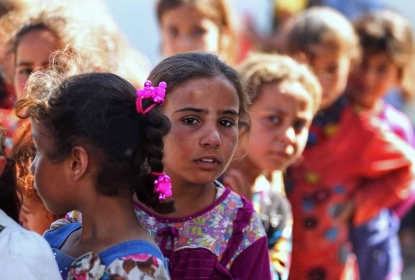 Displaced children stand in line to get food at the Hammam al-Alil camp for internally displaced people south of Mosul, on May 25, 2017, as government forces continue their offensive to retake the city of Mosul from Islamic State (IS) group fighters. (AFP / Ahmad Al-rubaye)
Displaced children stand in line to get food at the Hammam al-Alil camp for internally displaced people south of Mosul, on May 25, 2017, as government forces continue their offensive to retake the city of Mosul from Islamic State (IS) group fighters. (AFP / Ahmad Al-rubaye)





